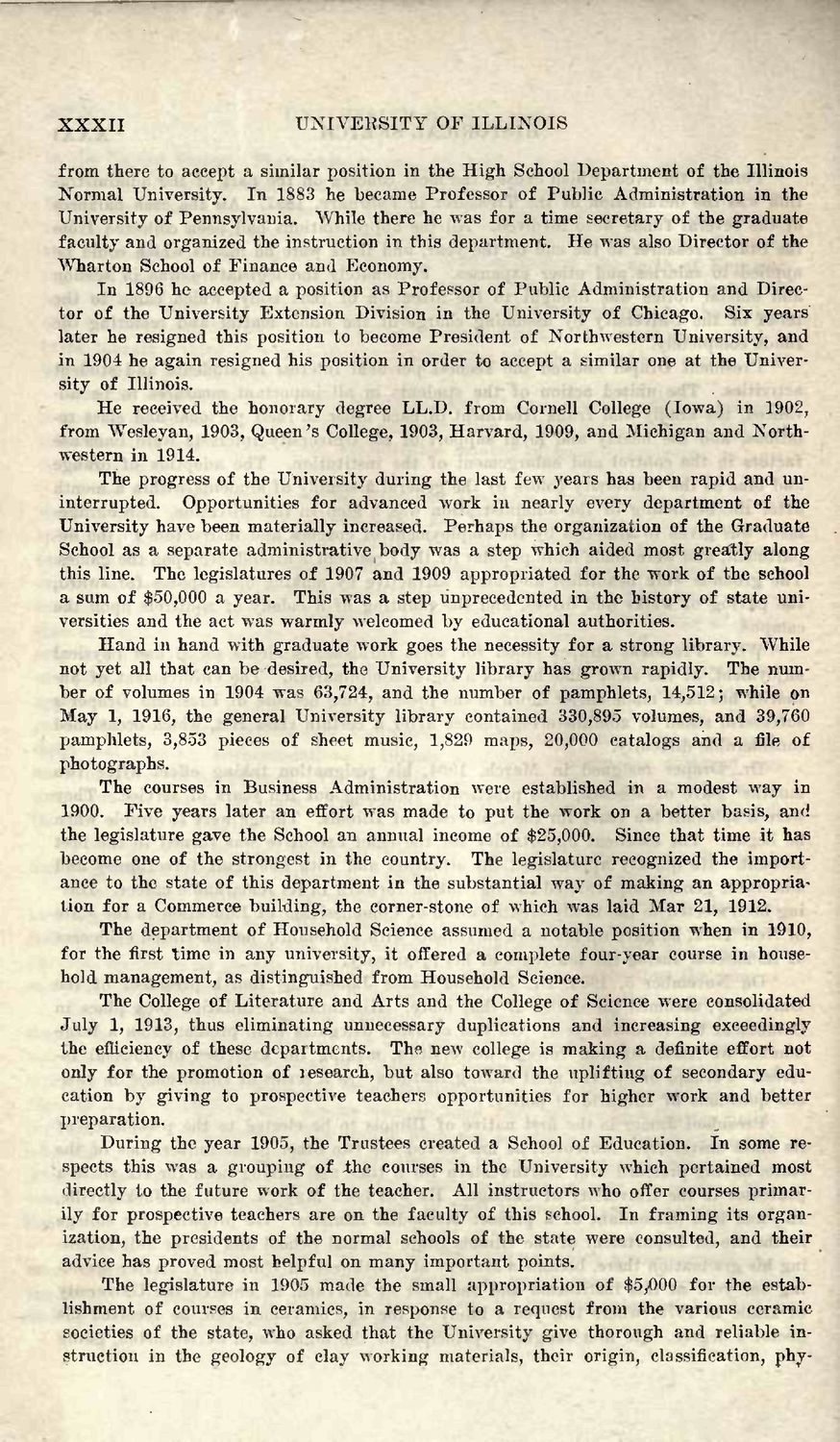| |
| |
Caption: Book - Early History of University (1916)
This is a reduced-resolution page image for fast online browsing.

EXTRACTED TEXT FROM PAGE:
XXXII U N I V E R S I T Y OF I L L I N O I S from there to accept a similar position in the High School Department of the Illinois Normal University. I n 1883 he became Professor of Public Administration in the University of Pennsylvania. While there he was for a time secretary of the graduate faculty and organized the instruction in this department. He was also Director of the Wharton School of Finance and Economy. In 1896 ho accepted a position as Professor of Public Administration and Director of the University Extension Division in the University of Chicago. Six years later he resigned this position to become President of Northwestern University, and in 1904 he again resigned his position in order to accept a similar one at the University of Illinois. He received the honorary degree LL.D. from Cornell College (Iowa) in 1902, from Wesleyan, 1903, Queen's College, 1903, Harvard, 1909, and Michigan and Northwestern in 1914. The progress of the University during the last few years has been rapid and uninterrupted. Opportunities for advanced work in nearly every department of the University have been materially increased. Perhaps the organization of the Graduate School as a separate administrative body was a step which aided most greatly along this line. The legislatures of 1907 and 1909 appropriated for the work of the school a sum of $50,000 a year. This was a step unprecedented in the history of state universities and the act was warmly welcomed by educational authorities. Hand in hand with graduate work goes the necessity for a strong library. While not yet all that can be desired, the University library has grown rapidly. The number of volumes in 1904 was 63,724, and the number of pamphlets, 14,512; while on May 1, 1916, the general University library contained 330,895 volumes, and 39,760 pamphlets, 3,853 pieces of sheet music, 1,829 maps, 20,000 catalogs and a file of photographs. The courses in Business Administration were established in a modest way in 1900. Five years later an effort was made to put the work on a better basis, and the legislature gave the School an annual income of $25,000. Since that time it has become one of the strongest in the country. The legislature recognized the importance to the state of this department in the substantial way of making an appropriation for a Commerce building, the corner-stone of which was laid Mar 21, 1912. The department of Household Science assumed a notable position when in 1910, for the first time in any university, it offered a complete four-year course in household management, as distinguished from Household Science. The College of Literature and Arts and the College of Science were consolidated July 1, 1913, thus eliminating unnecessary duplications and increasing exceedingly the efficiency of these departments. The new college is making a definite effort not only for the promotion of research, but also toward the uplifting of secondary education by giving to prospective teachers opportunities for higher work and better preparation. During the year 1905, the Trustees created a School of Education. In some respects this was a grouping of .the courses in the University which pertained most directly to the future work of the teacher. All instructors who offer courses primarily for prospective teachers are on the faculty of this school. In framing its organization, the presidents of the normal schools of the state were consulted, and their advice has proved most helpful on many important points. The legislature in 1905 made the small appropriation of $5/)00 for the establishment of courses in ceramics, in response to a request from the various ceramic societies of the state, who asked that the University give thorough and reliable instruction in the geology of clay working materials, their origin, classification, phy-
| |